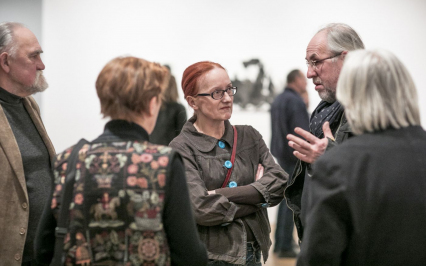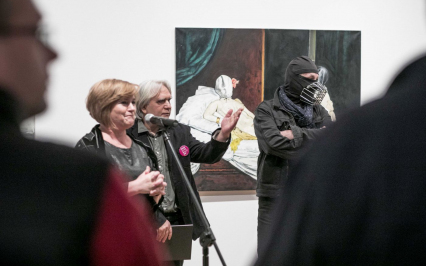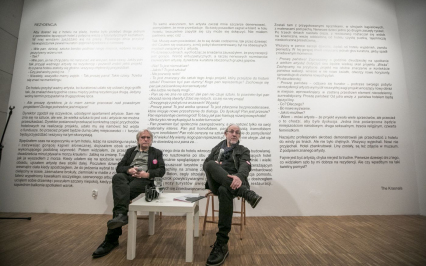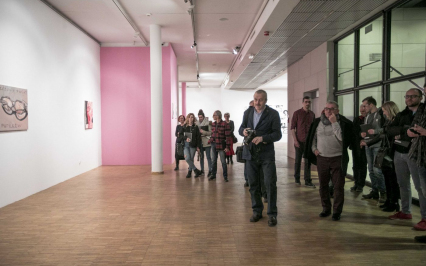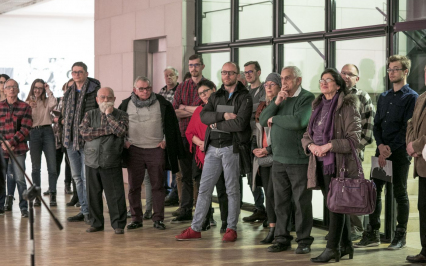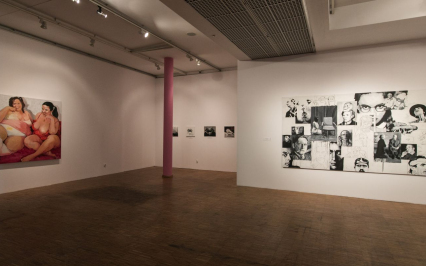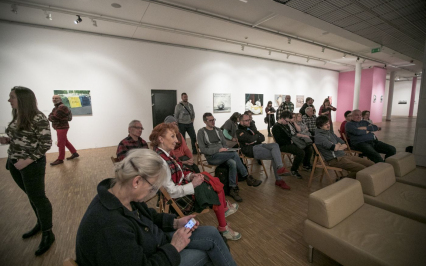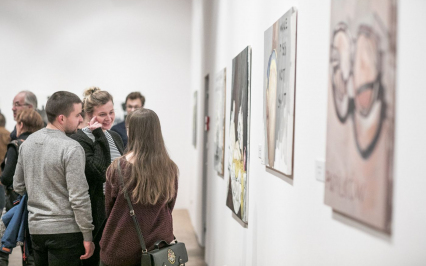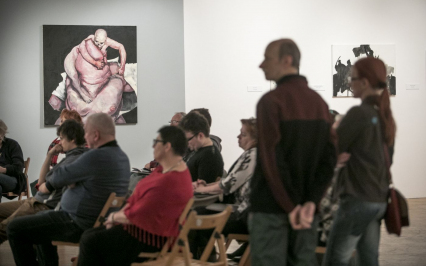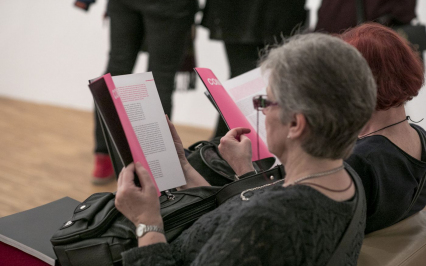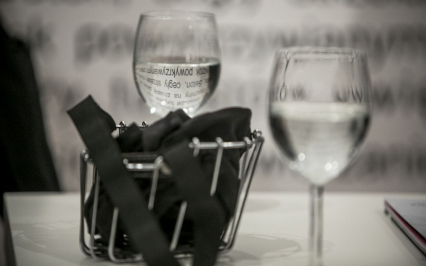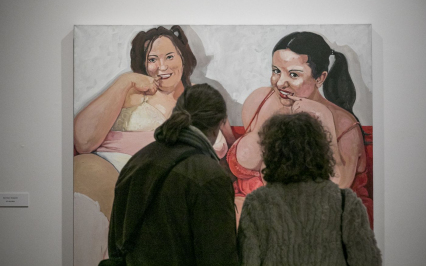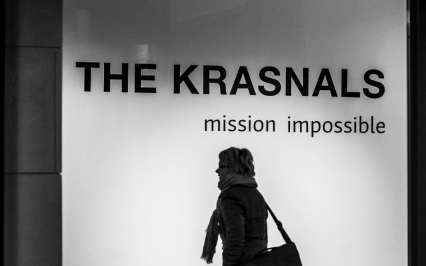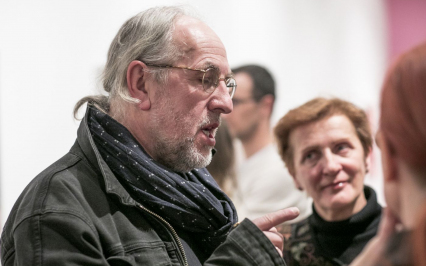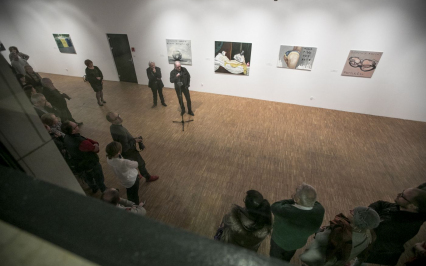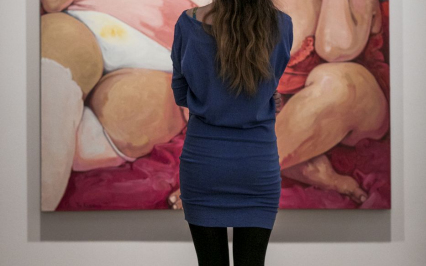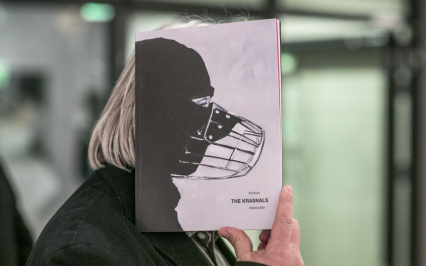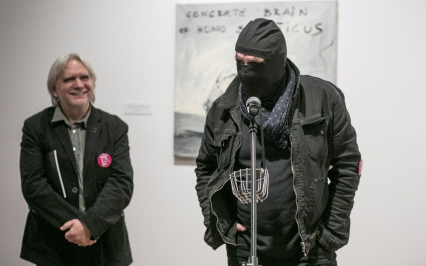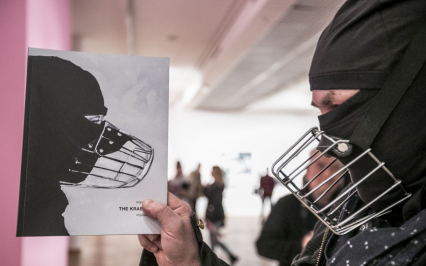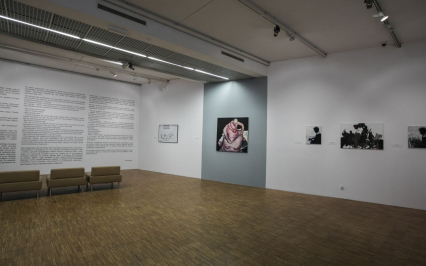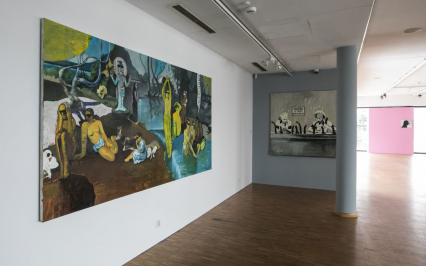The Krasnals "Mission Impossible"
9 March - 22 April 2018
Galeria BWA SOKÓŁ
vernissage:
9 March 2018, hour 18:00
The Krasnals is an artistic group that was founded in March 2008. Its members do not reveal their identity, age or gender. During public appearances always appear in masks. They work exclusively on the internet, where they create literary, plastic and film comments on current reality on the blog they created. They react quickly, brilliantly sometimes bluntly, and even vulgar.
The starting point for the Krasnals activity was Wilhelm Sasnal's career. Using a pastiche and artistic paraphrase, creating Sasnal-style paintings, they began to unmask the mechanisms of this success, undermine the legitimacy of the hierarchy of artistic criteria, and uncover the principles of the Polish art scene.
artinfo.pl
Comic strips.pl
There is no doubt that the creation of the works of the anonymous group The Krasnals and even the creation of the group itself would never have happened if only artistic premises had to decide about it. Indeed, oil paintings on canvases, the main medium for which they reach Krasnalsi, situate them in the area traditionally reserved for artistic expression, but it is clear, especially today, after 10 years of significant presence of the formation, that the meaning and power of visualizing works, constitute their inherent basics, "social" reasons.
The fact is that in this case these reasons - in the majority - refer to the principles of the functioning of culture and its almost inhuman surroundings. As The Krasnals would say, to the critique of lumpenkulture, that is a familiar version of the world fashion of participation in the game, in which you do not have to strain anymore, and the most appropriate is the dose of impudence. Where everything goes under the condition ACCEPTING THE PRINCIPLES OF CLASSIFICATION and the designated place in the row. In a word: where the ceiling of creative aspirations is determined by the dream of own, even the smallest role in the full structure of the high permissive society of the global art market.
Around 2007, the time when the idea of forming a collective grew among the originators of The Krasnals, Wilhelm Sasnal was the star of several artistic seasons. A Polish icon as much expressive as a dubious career in art. Unclear, both in the matter of assessing the painting values building it, and in the plan of the extremely enigmatic provenance of the sudden revelation and wholesale demand. It was this over-exposed and over-recognizable Tarnów brand that stood behind the immediate impulse of using the Sasnal / Krasnal license, with the sophisticated Anglo-Saxon The, at the amusing condominium of the local gnome. The new concept of such a header perfectly advertised the neo -advertising project of the group in a thorough way, and thus, the sarcastic revolution of its images should soon come. More related to the etymology of IMAGES, than IMAGES. Their recipient, according to the intention of the author, in a reaction should not be smacked with expert knowledge, but to pokapiać, like in the toilet inscriptions. Exactly like there: with disapproval, though for namolną necessity.
Picture ethnography
Putting on a journalistic variant of intervention, The Krasnals, on the one hand, mimicked Sasnal's method to postpone it as a typical prescription act, exhibited in the world centers of prestige distribution, and on the other hand, as a kind of strategy, they are very handy. After all, it was not about racing with your alter ego, "in the subtleties of the workshop", but about the unmasking power and thundering effect. At the same time Krasnalsów game has always been and is still being fought in double disguise: if in public space, it is in black balaclavas with muzzle, and when in the studio, it is a painter's white coat.This is about a skillful conduct of a dispute, involving the adversary's fight with his arguments, and not on dazzling skills - de facto - second hand. For this reason, for a complete misunderstanding should be considered ambitions of some of the group's critics - usually the chronic heralds of the Pharisaic system of selling "ours", suddenly rushing to unmask the workshop imperfections of The Krasnals. The same correctness enthusiasts who, in relation to their "own", have repeatedly demonstrated the fundamental "lack of rigor in the matter of values". Well, and probably in terms of elementary logic, because pointing out formal deficiencies to the program mockers of such shortcomings must inevitably be marked by a mark (without) of critical aberration, or ... tactics to order.
In the meantime, the Krasnalsi began to particularly exhibit what - as they soon discovered - is the most appealing in the art of not reaching the level of aesthetic and intellectual elites. After all, the answer was not complicated. This is something of course
Vulgarity
which normally, on the average, a cultural individual forbids the sense of decency, upbringing and the code of morals. This is the source of satisfaction and even euphoria when you suddenly do not have to pretend anything, and in exquisite temples of taste, even in official art galleries, people can satisfy their secret, often suppressed, or even unconscious and even more powerful tastes. Often, there are no plays, but the fun is front. The reserves in it were quickly annexed by Krasnalsi, often dragging the string of risk of the accuracy of his persuasion to the border of the scandal. If they can not, because the pedal's aesthetic arguments can be pressed more tightly, they can turn on the verbal amplifiers in the comic cloud, with the whole arsenal of gutter savoir-vivre. Reserves seem inexhaustible, as do the genre's achievements, when we realize that such story-telling stories have quite a serious tradition in the history of art. After all, the Egyptian pharaohs and Roman emperors ordered to sculpt the history of their triumphs on the columns. Stations of the Lord's Passion and medieval hagiography also somehow belong to this category. Finally, the comic book in extenso is the famous fabric from Bayeux, where words are staged among the battle scenes, which explain what is happening there. Of course, they translate the translator's thoughts.
In centuries-old stories, picture stories have always had a practical purpose - moral or political - were something like a propaganda poster, but at the same time - let us admit - they were betrayed by the artists of the fastidious taste. Today, this last element, as it is needed, is also lost in the service of transmission efficiency (vide New Yorker). And, like some medicines: wasting havoc with taste, it supplies food that has never been known before, and now the most up-to-date hunger.
Andrzej Biernacki
artinfo.pl
Comic strips.pl
There is no doubt that the creation of the works of the anonymous group The Krasnals and even the creation of the group itself would never have happened if only artistic premises had to decide about it. Indeed, oil paintings on canvases, the main medium for which they reach Krasnalsi, situate them in the area traditionally reserved for artistic expression, but it is clear, especially today, after 10 years of significant presence of the formation, that the meaning and power of visualizing works, constitute their inherent basics, "social" reasons.
The fact is that in this case these reasons - in the majority - refer to the principles of the functioning of culture and its almost inhuman surroundings. As The Krasnals would say, to the critique of lumpenkulture, that is a familiar version of the world fashion of participation in the game, in which you do not have to strain anymore, and the most appropriate is the dose of impudence. Where everything goes under the condition ACCEPTING THE PRINCIPLES OF CLASSIFICATION and the designated place in the row. In a word: where the ceiling of creative aspirations is determined by the dream of own, even the smallest role in the full structure of the high permissive society of the global art market.
Around 2007, the time when the idea of forming a collective grew among the originators of The Krasnals, Wilhelm Sasnal was the star of several artistic seasons. A Polish icon as much expressive as a dubious career in art. Unclear, both in the matter of assessing the painting values building it, and in the plan of the extremely enigmatic provenance of the sudden revelation and wholesale demand. It was this over-exposed and over-recognizable Tarnów brand that stood behind the immediate impulse of using the Sasnal / Krasnal license, with the sophisticated Anglo-Saxon The, at the amusing condominium of the local gnome. The new concept of such a header perfectly advertised the neo -advertising project of the group in a thorough way, and thus, the sarcastic revolution of its images should soon come. More related to the etymology of IMAGES, than IMAGES. Their recipient, according to the intention of the author, in a reaction should not be smacked with expert knowledge, but to pokapiać, like in the toilet inscriptions. Exactly like there: with disapproval, though for namolną necessity.
Picture ethnography
Putting on a journalistic variant of intervention, The Krasnals, on the one hand, mimicked Sasnal's method to postpone it as a typical prescription act, exhibited in the world centers of prestige distribution, and on the other hand, as a kind of strategy, they are very handy. After all, it was not about racing with your alter ego, "in the subtleties of the workshop", but about the unmasking power and thundering effect. At the same time Krasnalsów game has always been and is still being fought in double disguise: if in public space, it is in black balaclavas with muzzle, and when in the studio, it is a painter's white coat.This is about a skillful conduct of a dispute, involving the adversary's fight with his arguments, and not on dazzling skills - de facto - second hand. For this reason, for a complete misunderstanding should be considered ambitions of some of the group's critics - usually the chronic heralds of the Pharisaic system of selling "ours", suddenly rushing to unmask the workshop imperfections of The Krasnals. The same correctness enthusiasts who, in relation to their "own", have repeatedly demonstrated the fundamental "lack of rigor in the matter of values". Well, and probably in terms of elementary logic, because pointing out formal deficiencies to the program mockers of such shortcomings must inevitably be marked by a mark (without) of critical aberration, or ... tactics to order.
In the meantime, the Krasnalsi began to particularly exhibit what - as they soon discovered - is the most appealing in the art of not reaching the level of aesthetic and intellectual elites. After all, the answer was not complicated. This is something of course
Vulgarity
which normally, on the average, a cultural individual forbids the sense of decency, upbringing and the code of morals. This is the source of satisfaction and even euphoria when you suddenly do not have to pretend anything, and in exquisite temples of taste, even in official art galleries, people can satisfy their secret, often suppressed, or even unconscious and even more powerful tastes. Often, there are no plays, but the fun is front. The reserves in it were quickly annexed by Krasnalsi, often dragging the string of risk of the accuracy of his persuasion to the border of the scandal. If they can not, because the pedal's aesthetic arguments can be pressed more tightly, they can turn on the verbal amplifiers in the comic cloud, with the whole arsenal of gutter savoir-vivre. Reserves seem inexhaustible, as do the genre's achievements, when we realize that such story-telling stories have quite a serious tradition in the history of art. After all, the Egyptian pharaohs and Roman emperors ordered to sculpt the history of their triumphs on the columns. Stations of the Lord's Passion and medieval hagiography also somehow belong to this category. Finally, the comic book in extenso is the famous fabric from Bayeux, where words are staged among the battle scenes, which explain what is happening there. Of course, they translate the translator's thoughts.
In centuries-old stories, picture stories have always had a practical purpose - moral or political - were something like a propaganda poster, but at the same time - let us admit - they were betrayed by the artists of the fastidious taste. Today, this last element, as it is needed, is also lost in the service of transmission efficiency (vide New Yorker). And, like some medicines: wasting havoc with taste, it supplies food that has never been known before, and now the most up-to-date hunger.
Andrzej Biernacki
Vernissage
On March 9, 2018, at 6:00 pm, the opening of the exhibition Adam Myjak, sculpture and drawing took place. We invite you to view photos.




